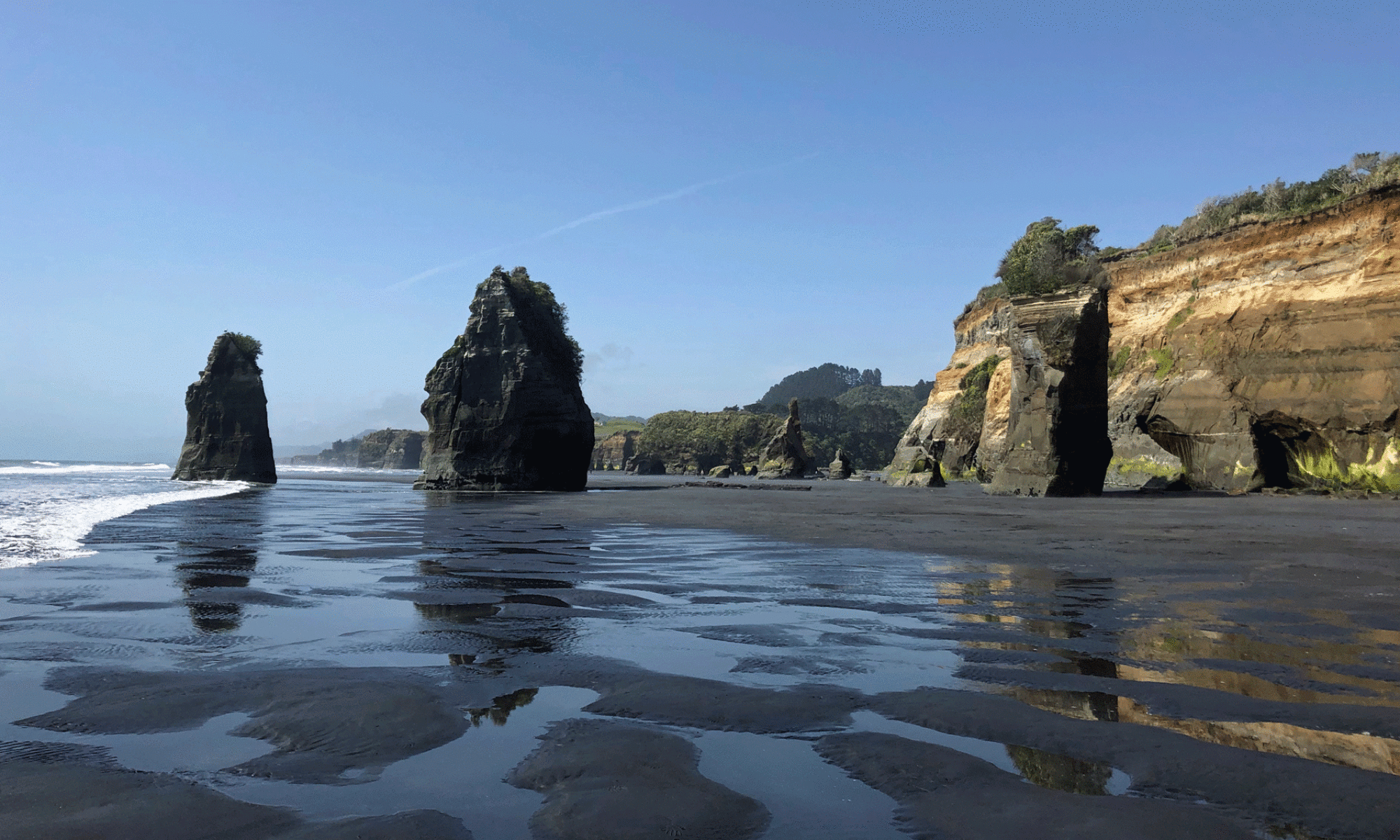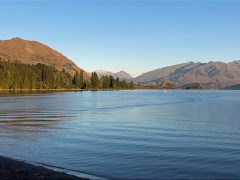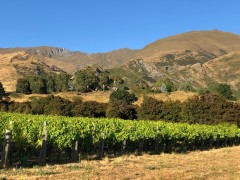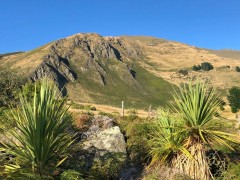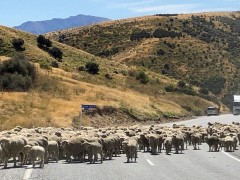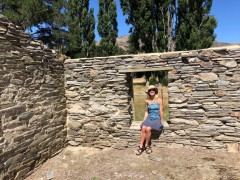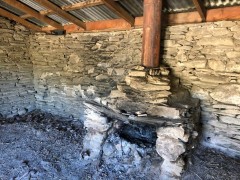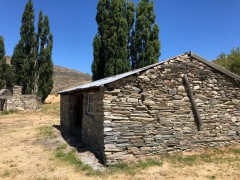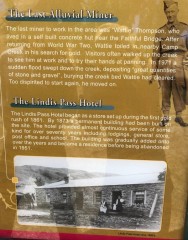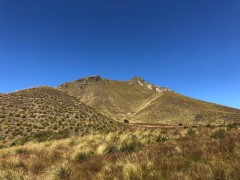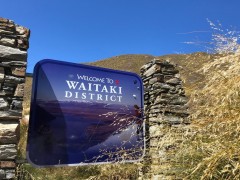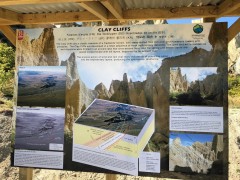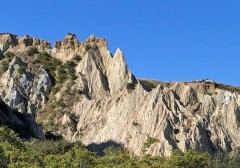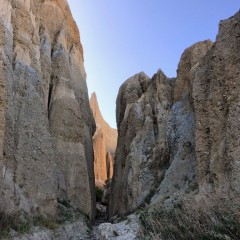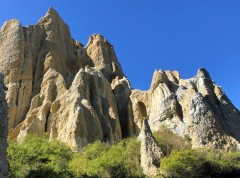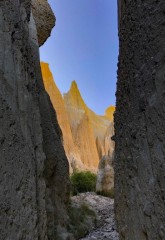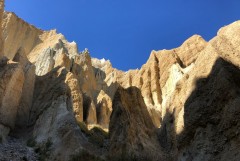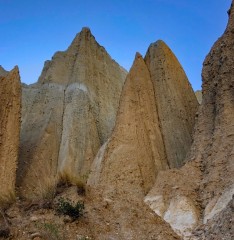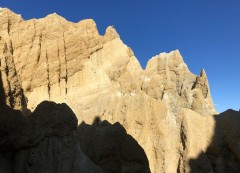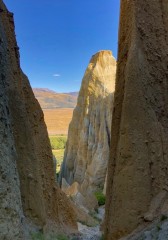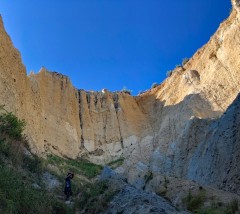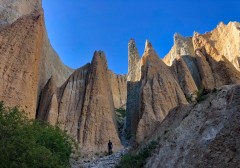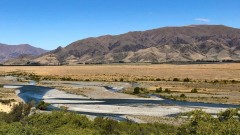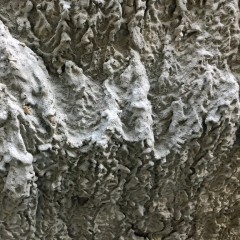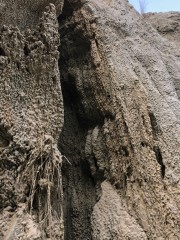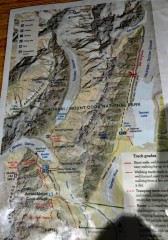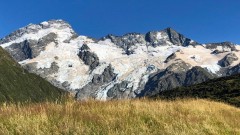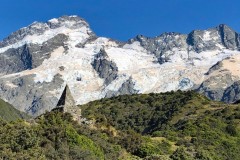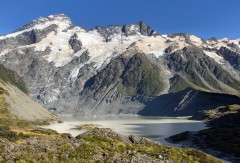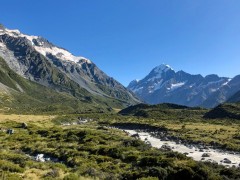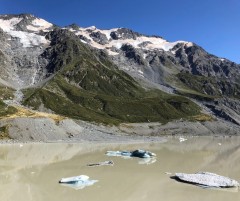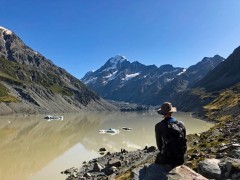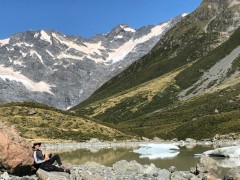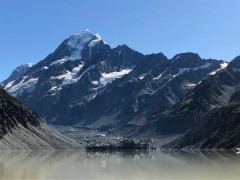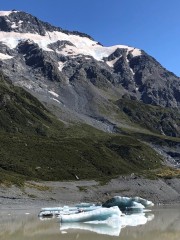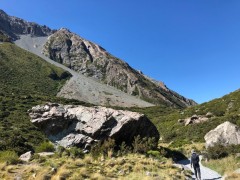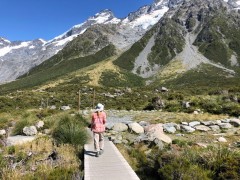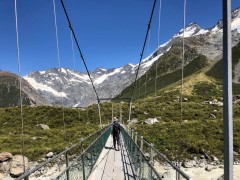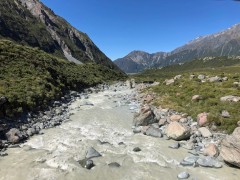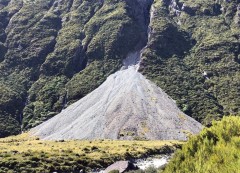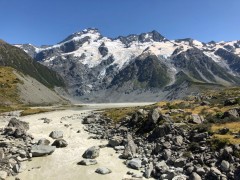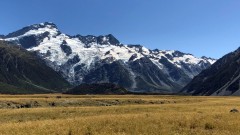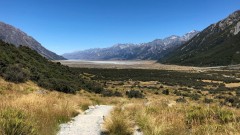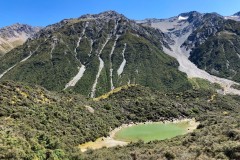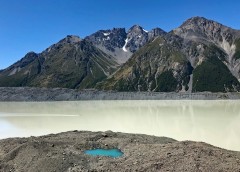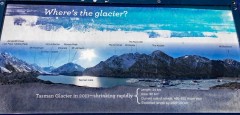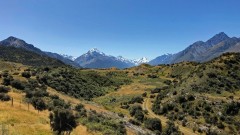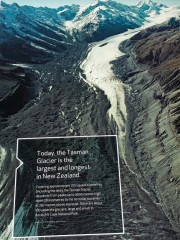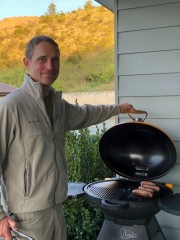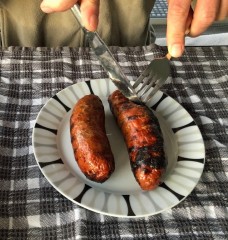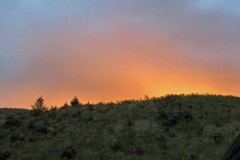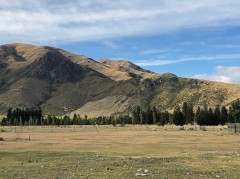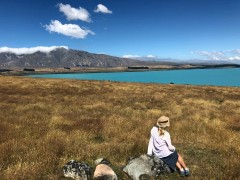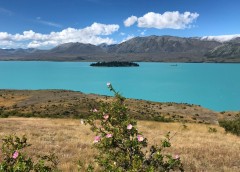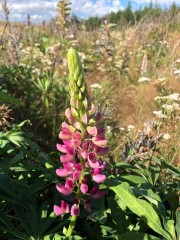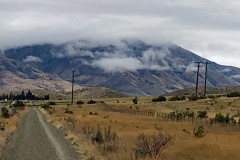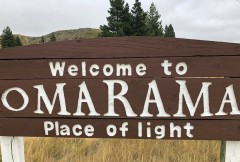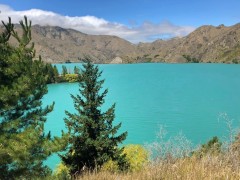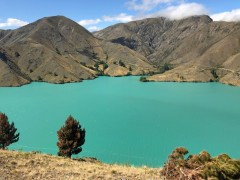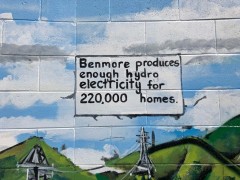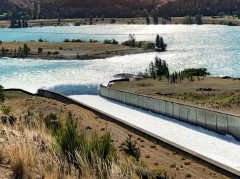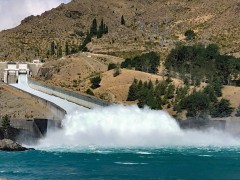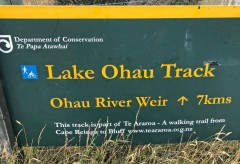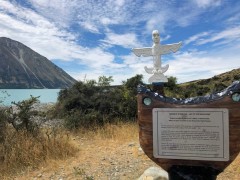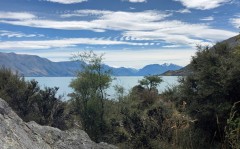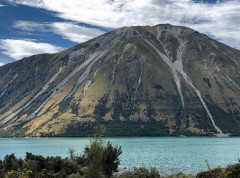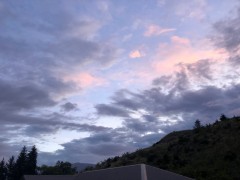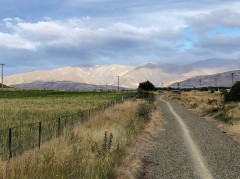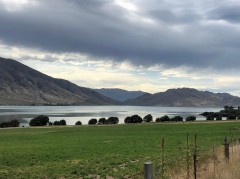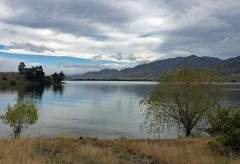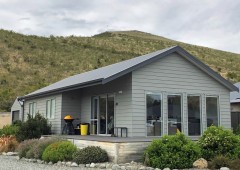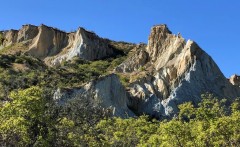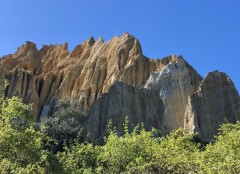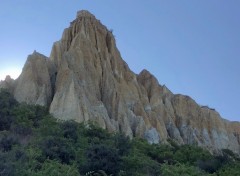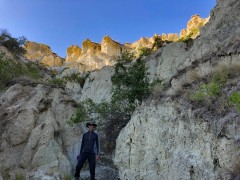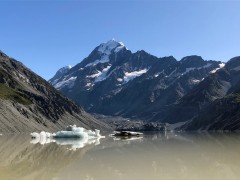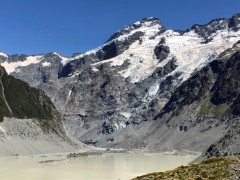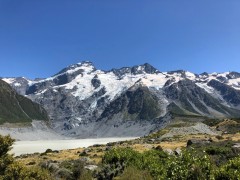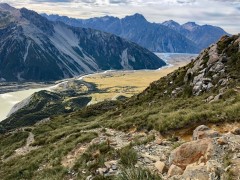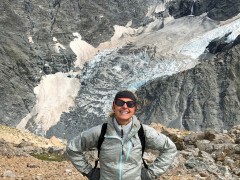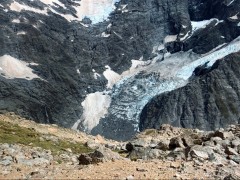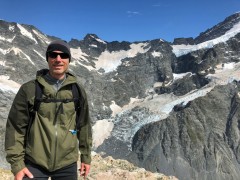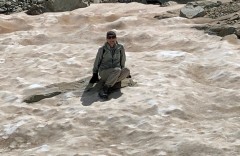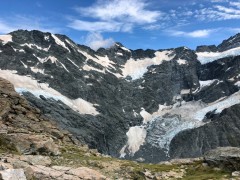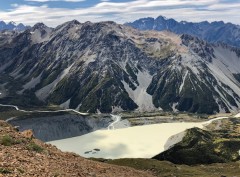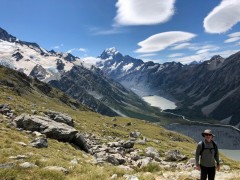A quiet town with access to a plethora of Aotearoa’s picturesque wonders
This is our week to see Aoraki/Mt Cook, New Zealand’s highest mountain, and also the much photographed Lake Tekapo. There’s very little in Omarama proper (unless you are into gliding), but it gave us access to both the most acclaimed natural wonders and to several quieter beauties set in this dry landscape of pale hills and strikingly blue lakes.

We were meant to be staying closer, in Twizel, but had to rebook a couple of weeks prior due to a planned power outage for most of the week there. We were back in the “high country” here where in summer it is hot as blazes in the daytime sun, but cool at night.
Monday – Move Day
A last morning walk along the Wanaka shore both ways on a crystal clear morning, showing off the snowcapped mountains, red hills and green vineyards to perfection against the blue of the lake. Home to pack and clean and then a little shopping in Wanaka since we’ll be in the middle of nowhere this week.
We finished our stint in Wanaka with a surprisingly nice coffee experience at New World (grocery store.) If you spend a certain amount, you get a 2NZD coffee. We had two and expected a paper cup that we would carry around while shopping, but instead we were able to sit outside in a café with mountain views and real mugs enjoying our cashew milk flat whites for the equivalent of USD 2.50 total. Sweet as! (That standard NZ lingo was especially appropriate here since the coffees were served with little shortbread cookies.)

It was only a short 1.5 hour drive today, but with a carload of groceries we didn’t want to add a long hike. We spiced up the trip stopping to marvel at Lindis Pass and with a slight detour to see the historic hotel which was built during Otago’s first gold rush.
The gold rush never panned out (ha – that’s where that saying comes from) but the hotel remained operational in some form for 70 years. Recently DOC and volunteers restored it.
Once moved in to our house for the week, we drove a short ways to the Clay Cliffs of Omarama for a look around. These tall pinnacles separated by narrow ravines are made up of layers of gravel and silt, formed by the flow from ancient glaciers over a million years ago and then shaped by the other environmental forces at work in the time since.

Set on private land, the owner makes them available to the public with just a small donation needed for ensuring safe road, etc. It was fantastic and we had a fun time climbing around the “cathedral” and exploring as far as we could go up the various gulleys and canyons.
Tuesday
Aoraki National Park, a land of wonders. From DOC: “Aoraki/Mount Cook National Park is a rugged land of ice and rock, with 19 peaks over 3,000 metres including New Zealand’s highest mountain, Aoraki/Mount Cook. The park is also part of Te Waipounamu – South Westland World Heritage Area in recognition of its outstanding natural values.” In the Māori culture, Aoraki means “Cloud Piercer.” (Europeans “named” it Mt Cook, after the same guy who “discovered” so many inhabited Pacific islands.)

Aoraki is right in the middle of the Southern Alps. None of the three passes over the Alps are anywhere near here, so the road into the park is a dead end. (Amazingly, the very heavily touristed Fox and Franz Joseph Glaciers are just 30 km away through the park. To get there, you have to drive hundreds of kilometers north or south to a pass and then back into the Alps from the other side.)
Aoraki is skipped by many on the tourist track, but we still found it to be quite busy with loads of campervans, motorhomes, rental cars and the occasional tour bus. We weren’t begrudging the crowds though. Anyone who has the chance should see this outrageously spectacular place and we feel so very privileged to be doing so.

We started with the very popular Hooker Valley Track. It is a crowded and easy hike, but absolutely striking. (It is wonderful that NZ has walks like this that anyone with moderate fitness can do. We do wonder though why many of the people we passed looked strangely grumpy and unhappy for being in one of earth’s most scenic and awe-inspiring places?)

Hanging Glaciers abound. Green hills and rocky crags above. Beautiful – actually stunning and mind numbing. The hike ends at a glacial lake with the tip of the Hooker Valley Glacier with Aoraki rising in the background at one end and several other mountains framing the other end. Mountain valley scenery at its best.

But the absolute best were the icebergs floating around in the lake! Unbelievable to a couple of middle-US born and raised kids. We could have stayed watching them for hours, but also thoroughly enjoyed the hike back along the valley floor and across multiple swing bridges over the glacial river on its tumble down into the next lake.
In the afternoon, we went to see the Tasman Glacier – the biggest in NZ at 23.5 km long, up to three km wide, and 101 sq km and about 600 meters deep at its deepest. After a picnic in the shade of a shelter (it was roasting in the afternoon sun), we took an easy walk up to a viewpoint of the “Blue Lakes” and then of the Tasman Glacier itself. This glacier is receding so quickly that the retreat is obvious in the changes even our untrained eyes can see. This Tasman Lake didn’t even exist when we were born as this whole area was then itself glacier.

From Wikipedia: “The glacier remained at a constant 28 km (17 mi) in length for all of its recorded history in the 20th century before starting its current period of rapid melting in the 1990s. Between 2000 and 2008 alone, the glacier terminus receded 3.7 km. Since the 1990s the terminus has retreated about 180 metres (590 ft) a year on average. The glacier is now in a period of faster retreat where the rate of retreat is calculated to be between 477 to 822 metres (1,565 to 2,697 ft) each year. It is estimated that the Tasman Glacier will eventually disappear and the terminal Tasman Lake will reach a maximum size in 10 to 19 years’ time. In 1973 Tasman Glacier had no terminal lake but by 2008 Tasman Lake was 7 kilometres (4.3 mi) long, 2 kilometres (1.2 mi) wide, and 245 metres (804 ft) deep.”
Our drive home along Lake Pukaki was another shock to the senses. We truly felt like we were scenically saturated to the point of overload looking down into the Tasman valley, but this jolted us back into awe.

The lake is an unreal shade of blue – caused by the fine pieces of glacial silt floating within the water. We kept pulling over for pictures, none of which actually captured it.

Taking advantage of the Alps2Ocean bike trail, we took a short walk along Pukaki’s south shore, but it was too hot to really enjoy. Home for venison sausages on the grill (Hale) and beet burgers for me.
Wednesday – Mueller Hut Track Separate Post
Thursday
Rainbow with the sunrise. We had planned for a rainy day so I had a quiet morning with a walk along the A2O in town while catching up with a dear friend and then laptop time. We’re making ever so slight progress on planning the next few months but I need to take a break to do some picture and journal maintenance.

The weather turned sunny and clear so we drove north to Lake Tekapo, another lake filled with glacial silt water and the most famous of New Zealand’s lakes. It is truly beautiful and we admire its turquoise majesty from two short hikes.
But first, we stopped in the town center for a map and it is a true tourist hub (trap?) filled with shops, restaurants and people wandering out of restaurants wearing their bus badges. We checked out the famous stone church on the shore, but honestly, it’s not all that so we were happy to head ever so slightly out of town to find more of our usual scene – a few scattered people and much more scenic wonder.

The first walk was along the shoreline, around a peninsula that juts out into the lake. It was another hot scorcher under the NZ sun, but the breeze had picked up making for a very pleasant picnic and stroll through golden fields overlooking the uniquely opaque aqua blue of Tekapo. We found our way down to the white bluffs along the shore with the help of a European couple but we missed the morning sun angle for their full impact.

The second track was up the hill to the top of Mt John, where there is an observatory and research station. This is in the Dark Sky reserve and also has some of the cleanest air in the world. (I was hating that we ended up in Omarama which has more streetlights than people – such a shame that we couldn’t see the night sky from our deck when this massive internationally renowned reserve was mere kilometers away!)

The track is not steep at all, but my thighs were definitely letting me know that I abused them on the Mueller track. From the top, we had 360 views of the nearby mountains, the more distant alps, the sparkling aqua lake and the dark blue Lake Alexandrina on the other side – a mountain lake rather than a glacial lake so an entirely different color. The walk down through the shaded birch forest is lovely and then we had a windy drive home.
Passing Lake Pukaki again, we decided that even though it has no village to attract tourists, it is by far the more majestic of these two matching turquoise lakes. With Aoraki and the Alps rising directly behind the northern shore, there is simply not a more picturesque view that I can imagine.
Friday
I started the day with a morning walk along A2O trail. Omarama is (slightly) growing on me. Then it was on to journal catch up and planning time. After looking at it from all angles, I booked us tickets to Fiji and on to PDX in July. Wow! We’re not only going to go back to the states so soon (more on that later) but we’re stopping at a South Pacific island on the way! (The number of miles for this flight with stopover was ridiculously low compared to any other NZ to US option.) I also booked a hotel, but then started playing with idea of a small island option instead.
In the afternoon, we drove out to nearby Lake Benmore for a hike up and around a peninsula with great views over its striking aqua colored octopus arms and green islands. Our book recommended a back road drive around neighboring Lake Aviemore and we did part of it but turned back as storm clouds rolled in.

This area relies heavily on hydro power so many of these lakes are dammed and the dam for Lake Benmore is absolutely fascinating. It is NZ’s largest earthen dam (made out of dirt not concrete) and we were lucky enough to see it on a day that, in addition to the power generating pipes, they were releasing water through the overflow chute. The power of that rush of water is astonishing to behold.
Home for a “salon” evening where we had a couple of epic failures trying to do my hair at home for the first time since we lived on our sailboat Cayuga. Luckily, I don’t have to look presentable for a career any longer.
Saturday
I enjoyed a cloudy morning with an A2O walk while catching up with a former work colleague. There was one more lake in the area that I wanted to see, so we drove over to Lake Ohau and took a long, hot, still walk along its shore on another section of the A2O trail.

Lake Ohau has one housing development and one ski lodge/ski area and that’s it. If you want remote skiing on striking mountains, over an aquamarine lake with views of the Alps starring Aorkaki at the end of the lake, I have the place for you.
We were not sure if it was the weather or if we had simply hit overload with all the incredible beauty we had seen recently, but we felt saturated and unable to appreciate any more awe. Strange when we knew we were experiencing yet another one-of-a-kind scenic beauty spots.
Sunday
Purple sunrise with storm clouds looming. In what’s become a pattern, I took an A2O walk and talk with home. Then I greatly enjoyed a bike ride further along the A2O to Sailors Cutting on a very pretty path along a different part of Lake Benmore. It was fun to see a real Kiwi camping ground that seemed free of tourists and instead filled with people boating, fishing or just relaxing.
After a dash up to a corner farm stand for the last of the season’s cherries, I spent the afternoon/evening researching accommodations for our planned extra two months in NZ. When it started to finally cool, we took a short evening walk around “town.”
Wrap
Aoraki was truly captivating and overwhelmingly beautiful. I loved our days there. Everything else in the area, despite the gorgeous lake colors and backdrops, paled in comparison.
Looking back on the week, we can’t help but realize that this part of the country is unfairly rich in scenic wonders. We feel like that about New Zealand in comparison to so many other places in the world, and that sentiment is especially strong for us here.
Omarama (the town and our Airbnb for the week) were fine utilitarian and functional bases, but nothing to write home about. (We have become spoiled with the special apartments and charming towns which we have been visiting.)
